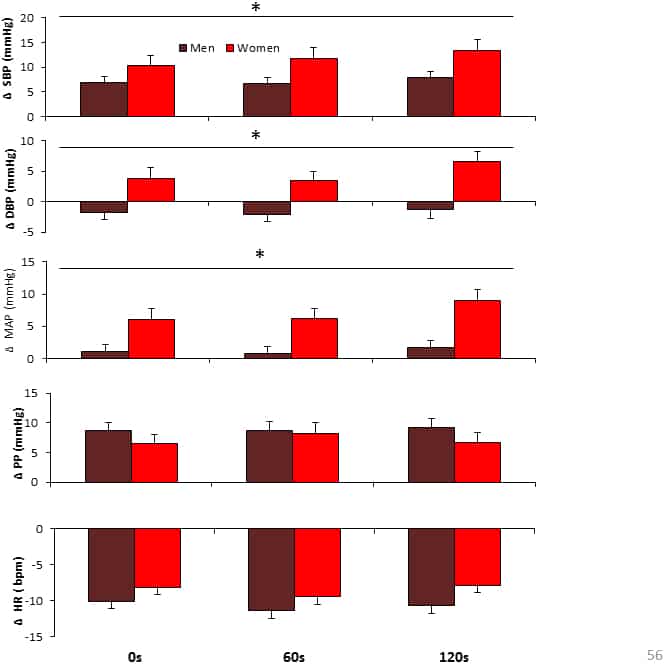Squatting, an active posture manoeuvre imposes one of the most potent orthostatic stresses. Analysis of BP and HR changes during change in posture from standing to squatting position provide information on performance of the baroreflexes and haemodynamic homoeostasis. This study aimed at determining the effect of prompt and sustained squatting on arterial blood pressure and heart rate in young Black Africans and to determine the gender differences in the responses . Method: Sixty five men (32) and women (33) aged 16-30 years were recruited. Following 10 minutes rest in sitting position by stood for 3 mins, then squatted for 2 minutes. Systolic and diastolic blood pressures (SBP, DBP) and heart rate (HR) were recorded using automated blood pressure monitor in sitting, standing and squatting positions. Mean arterial blood pressure (MAP) was calculated using the formula (1/3 Pulse pressure + Diastolic blood pressure) and Pulse Pressure (PP) was calculated using the formula; SBP – DBP. Differences in SBP, DBP, MAP, PP and HR between squatting position and standing were computed. Effect of prompt squat was determined using unpaired T test, effect of squatting at 0s, 60s and 120s was determined using repeated measures ANOVA. Statistical significance was determined at level of p<0.05. Result: Prompt squat was associated with increase in SBP (from 103.18±1.50 to 113.13±1.63mmHg, p=0.00), in MAP (from 78.19±1.08 to 81.45±1.32 mmHg, p=0.003),but DBP did not change (65.69±0.97 vs 66.61 ± 1.29 mmHg, p=0.42), leading to augmentation of PP (from 37.48 ± 0.97 to 44.52 ±1.08mmHg, p=0.00), with a decrease in HR (from 81.71 ± 1.53 to 72.26 ± 1.41bpm,p=0.00). Women showed greater increase in SBP (F(1,63)=4.03, p=0.049), DBP( F(1,63)=12.32,P=0.01) and MAP(F(1,63)=10.75,p=0.02) during squatting compared with men. But HR changes were not statistically significant between the two genders (F(1,63)=1.42, p=0.24)(Figure 1). In women but not in men, sustained squatting was associated with progressive increase in SBP, DBP and MAP. Conclusion: Squatting evoked increase in blood pressure, augmentation of pulse pressure with decrease in heart rate. Women showed greater blood pressure increases during squatting. These data highlight gender-specific responses to cardiovascular stress among young black African adults which requires further study to understand the mechanism of the responses.
Physiology 2019 (Aberdeen, UK) (2019) Proc Physiol Soc 43, PC019
Poster Communications: Sex differences in cardiovascular responses to postural stress among young Black African adults
A. O. Aiku1,2, E. Adagbada1, S. Ogbona1, A. Fasanmade1
1. Physiology, University of Ibadan, Ibadan, Oyo state, Nigeria. 2. Institute of Cardiovascular Sciences, University of Birmingham, Birmingham, United Kingdom.
View other abstracts by:
Figure 1: Showing change SBP,DBP, MAP, PP and HR values in mean � SEM during squatting from standing position. *p<0.05 men vs women.
Where applicable, experiments conform with Society ethical requirements.

